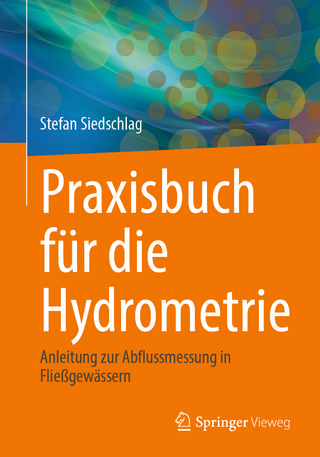
Controlled Drug Delivery Systems
CRC Press (Verlag)
978-1-032-65392-1 (ISBN)
appropriate delivery vehicles and relevant release of specific agents in any of these categories in clinical application will be discussed.
This book will describe current research on drug delivery systems that encompass four broad categories, namely: routes of delivery, delivery vehicles, payload, and targeting strategies. Where appropriate delivery vehicles and relevant release of specific agents in any of these categories in clinical application will be discussed. All chapters will highlight the translational aspects of the various technologies discussed and will provide insights into the advantages of such delivery systems over current ones in clinical or research use. Each technology reviewed in this book will have significant potential to improve patients' lives by enhancing the therapeutic efficacy of drugs.
This book:
Discusses the various factors that mitigate effective oral insulin delivery and the current status of research efforts to overcome these barriers along with recent clinical projections
Examines the advantages and disadvantages of each drug delivery system
Examines the standard method of accomplishing controlled drug release through the incorporation of the drugs within polymeric biomaterials such as capsules and microcapsules as well as other vehicles such as liposomes
Discusses various controlled drug delivery systems, including sustained release delivery systems and pulse or delayed release, e.g. to target different regions of the gastrointestinal tract.
In view of these wide-ranging technological areas, and the up-to-date discussions of opportunities and challenges associated with these applications, the book should provide readers from technology, materials science, pharmacology and clinical disciplines with very valuable information.
Professor Emmanuel C. Opara earned his PhD in Medical Sciences from the University of London, England. He came to the USA in 1984 as a World Health Organization (WHO) Fellow in Endocrinology/Metabolism at the Mayo Clinic in Rochester, Minnesota. He later moved to the National Institute of Diabetes, Digestive and Kidney diseases (NIDDK) of the National Institutes of Health in Bethesda Maryland, where he served as a Visiting Fellow from 1986 to 1988 prior to accepting a faculty position in the Department of Surgery at Duke University Medical Center, Durham, North Carolina. In 2003, after 15 years at Duke, he was appointed Research Professor at the Pritzker Institute of Biomedical Science and Engineering at the Illinois Institute of Technology (IIT), Chicago while serving as Senior Investigator in the Human Islet Transplant Program at the Pritzker School of Medicine of the University of Chicago. He currently serves as Professor of Regenerative Medicine and Biomedical Engineering at the Wake Forest School of Medicine and the Graduate Program Director at the Wake Forest University Campus of the Joint Virginia Tech-Wake Forest School of Biomedical Engineering and Sciences (SBES).
Foreword - David Williams; Preface – Emmanuel C Opara; Chapter 1: Introduction – Approaches to controlled drug delivery - Antonios Mikos; Chapter 2: Chemical modifications of alginate for controlled drug delivery and regenerative medicine - Mark E. Welker; Chapter 3: Hydrogel systems for delivery and release of cell-secreted and synthetic therapeutic products – Aleks Skardal; Chapter 4: The effect of glutathione incorporated as chain transfer agent in thermo-sensitive hydrogels for controlled release of therapeutic proteins – V Perez-Luna; Chapter 5: Controlled vaccine delivery – Kevin McHugh; Chapter 6: Controlled release of hormone by pellet implants – Sivanandane Sittadjody; Chapter 7: Delivery of ovarian hormones for bone health - Justin Saul; Chapter 8: Controlled delivery models of bioactive factors for the maturation of engineered tissues -Ashkan Shafiee & Atala; Chapter 9: Controlled delivery of angiogenic proteins – Eric M Brey; Chapter 10: Controlled therapeutic delivery in wound healing – Sean Murphy; Chapter 11: Leveraging plasma insulin estimates and wearable technologies to develop an automated insulin delivery system in Type 1 diabetes – A Cinar; Chapter 12: New developments in oral insulin delivery – Emmanuel C Opara; Chapter 13: Insulin delivery by a bioartficial pancreas– Will Kendall; Chapter 14: Transdermal drug delivery - Brahmeshwar Mishra; Chapter 15: Mucoadhesive chitosan-based nanoparticles for oral drug delivery - Shirui Mao; Chapter 16: Liposome-based delivery of therapeutic agents –Eneida de Paula; Chapter 17: Targeted intestinal delivery of probiotics – Emmanuel C. Opara
| Erscheinungsdatum | 23.08.2024 |
|---|---|
| Verlagsort | London |
| Sprache | englisch |
| Maße | 178 x 254 mm |
| Gewicht | 740 g |
| Themenwelt | Medizin / Pharmazie |
| Technik ► Umwelttechnik / Biotechnologie | |
| ISBN-10 | 1-032-65392-2 / 1032653922 |
| ISBN-13 | 978-1-032-65392-1 / 9781032653921 |
| Zustand | Neuware |
| Haben Sie eine Frage zum Produkt? |
aus dem Bereich


